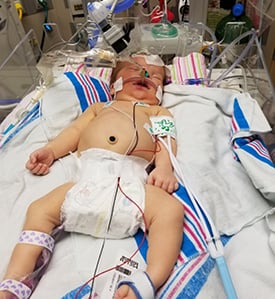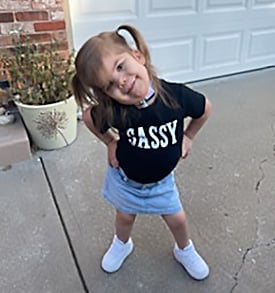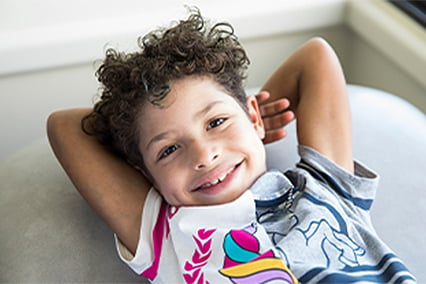Osteopathia Striata with Cranial Sclerosis: Emersyn’s Story
Meet Emersyn
Emersyn Gross is a sassy, fun 4-year-old who loves wearing her pink and purple tutus, pretending to be a doctor, and watching Peppa Pig. But when she was born Nov. 1, 2017, doctors weren’t sure she’d survive, and if she did, what her quality of life would be like.

“Emersyn was born at 38 weeks’ gestation,” said Sara Gross, Emersyn’s mom. “During my pregnancy, there weren’t any signs of problems, but at birth doctors noticed she had a cleft in her soft palate, a club foot and a hard, swollen abdomen.”
The hospital where Sara gave birth immediately transferred Emersyn to the Level IV Neonatal Intensive Care Unit (NICU) at Children’s Mercy Kansas City. There, doctors noted other red flags in the baby’s condition.
The most troubling was that Emersyn was struggling to breathe. Adriane Latz, MD, an otolaryngologist, or ear, nose and throat doctor, met Emersyn when she was admitted and diagnosed her with choanal atresia on the left side of her nasopharynx and choanal stenosis on the right.
“Emersyn’s most concerning problem was that at the back of her nostrils, one side was completely closed and the other had an extremely small opening, making it very difficult for her to breathe,” Dr. Latz explained. “She really did require a higher level of care.”
Normally, Dr. Latz could open this type of defect to improve a baby’s breathing, but when she tried to operate on Emersyn, she was surprised to find that the baby’s bone was harder than any she’d ever seen.
“The bone at the back of Emersyn’s nasopharynx was as hard as marble,” Dr. Latz said. “When I tried to drill through it to open it up, our metal instruments just bent.”
Emersyn’s head also was larger than most, her eyes were set wide apart and she had a couple of small holes in her heart. That combination of symptoms prompted the NICU doctors to order genetic testing for their patient, hoping it would provide much-needed answers to why Emersyn’s bones were so hard, and how to best treat her.
While waiting for the genetic test results, Emersyn’s family took her home briefly, but additional complications forced them to return to the hospital.
“I felt like we lived at Children’s Mercy and the Ronald McDonald House the first several months of Emersyn’s life,” Sara said.
Cracking the code
Jennifer Kussmann, MS, CGC, a genetic counselor at Children’s Mercy who specializes in working with patients and families in the hospital’s Elizabeth J. Ferrell Fetal Health Center and NICU, met Emersyn and her family when she was only two days old.
“The doctors suspected Emersyn had a rare genetic disorder,” Jennifer said. “We started testing with a chromosomal microarray to look for extra or missing pieces of genetic material.”
When that test didn’t provide the answers they were looking for, doctors ordered exome sequencing to spell check the DNA for Emersyn and her parents from the Children’s Mercy Genomic Medicine Center.
Children’s Mercy has the unique capability in house to offer patients and their families the advanced testing necessary to diagnose an array of rare genetic conditions.
“That’s an important difference between Children’s Mercy and other hospitals,” Jennifer said. “With our Genomic Medicine Center right here, we can perform symptom-driven genetic testing on site that might explain why a baby’s body is formed or functions differently.”
In Emersyn’s case, exome sequencing targeted the genes known to affect the development of the head and palate.
“Exome sequencing typically takes about 12 weeks,” Jennifer said. “Emersyn was diagnosed when she was only a couple of months old in January 2018.”
At that point, Jennifer met with Emersyn’s parents, Sara and Brian, to discuss her test results which revealed she has a rare genetic disorder called osteopathia striata with cranial sclerosis. The gene responsible for Emersyn’s genetic differences is called the AMER1 gene.
Like many patients at Children’s Mercy, there was no family history of this genetic difference. Emersyn is the first in her family with the condition, as well as the first to be diagnosed and treated at the hospital.
Most females with osteopathia striata have very hard bones, larger heads, eyes set wide apart, a depressed nasal bridge and a prominent jaw. Some also have small holes in their hearts, are smaller in stature and have other medical issues. Most females have normal intelligence.
Though it’s not known exactly how many people have this disorder, according to an article in Gene Reviews, only 100 cases in the world have been molecularly diagnosed.
Jennifer puts it in perspective. “Emersyn won’t ever bump into someone at the grocery store with the same condition. It’s very, very rare.
“If Emersyn had been admitted to the hospital a decade ago, we might never have known what caused her genetic variation,” Jennifer added. “This gene might not have even been discovered at that time.”
Diagnosis drives treatment
Fortunately, once Emersyn was diagnosed with osteopathia striata her family and Dr. Latz were able to learn more about the disorder.
“Having a rare disease can be very isolating for families,” Jennifer said. “But Emersyn’s mom did a great job of connecting with other families on social media who have children with this same disorder and learning about their care.”
Dr. Latz agreed. “Sara talked to the families and I talked to their doctors to better understand how they had treated this condition. Her parents are just amazing!”
Armed with what they had learned, Dr. Latz said their hope was that Emersyn might eventually breathe on her own, but a second surgery performed in March 2018 to open the bone at the back of her nostrils was unsuccessful.
“After surgery, Dr. Latz told us if she didn’t have a tracheostomy, she wouldn’t make it another month,” Sara said.
“We did everything possible to avoid a tracheostomy. It really is our last resort for airway treatment,” Dr. Latz added. “But without it, it was clear Emersyn wouldn’t survive.”
Winston Manimtim, MD, Children’s Mercy Neonatologist and Director of the hospital’s Infant Tracheostomy and Home Ventilator Program, met with Sara and Brian to explain the risks and benefits of a tracheostomy long term. After careful consideration, the couple agreed it was their daughter’s best chance at survival.
Dr. Latz performed the tracheostomy, making a hole in the front of Emersyn’s neck and into the windpipe (trachea). She then placed a tracheostomy tube in the hole to keep it open so Emersyn could breathe.
But there was much, much more involved in caring for Emersyn. Sara and Brian had to learn how to care for the tracheostomy at home, plus, she’d had a gastrostomy tube, or G-tube, placed to help with feeding. Dr. Latz also repaired a “floppy” voice box that was interfering with her breathing, and she was evaluated for possible seizures.
“Nothing with Emersyn has ever been textbook … ever,” Sara said. “For the feeding tube, they had to go through her mouth rather than her nose because of how small the opening is. She contracted a virus, got an infection in the opening for the G-tube and had an allergic reaction to the antibiotic she was on.”
Complication after complication extended her hospital stay, but Emersyn didn’t let that stop her. “Emersyn can overcome any challenge she faces,” Dr. Latz said. “She’s no shrinking violet!”
Sara agreed. “Once the tracheostomy and G-tube were in place, Emersyn began to thrive.”
Home sweet home
With help from the Children’s Mercy Infant Tracheostomy and Home Ventilator Program and nursing support 18 hours a day, Emersyn returned home in June 2018.
The Infant Tracheostomy and Home Ventilator Program gives Emersyn and other patients and families like hers the opportunity to have a sense of normalcy and thrive in an environment outside the hospital critical care units.
Through the clinic, Emersyn has still been able to receive the complex medical care she needs and have access to an on-call physician 24/7, as well as the multidisciplinary care team and the support of a local private duty nurse in the home.
She also has been followed in the program’s multidisciplinary clinic where all members of the team are available to see her, including neonatology, intensivists, otolaryngology, pulmonology, gastroenterology, physical therapy, occupational therapy, social work and a dietitian.
“The Home Vent Clinic is a huge advocate for us,” Sara said. “If we have issues with anything, I can tell them and they are 100% on top of it. They take care of things immediately and have helped us navigate Emersyn’s condition.”
“We’ve never had a patient like Emersyn before,” Dr. Manimtim said. “We’ve learned so much from her. Her lungs are normal, but without the tracheostomy, Emersyn could not survive outside the hospital. How long she’ll need it depends on whether her bone will open up as she grows, eventually allowing her to breathe.”
To stay as healthy as possible, Emersyn sees Dr. Latz and Dr. Manimtim quarterly. She has annual abdominal ultrasounds to screen for kidney tumors which have been noted in other children with the same condition, and she sees cardiology routinely to check her heart, which has remained stable.
She’s also had several other health issues addressed at the hospital since she was released. Concerned about how small her ear canals were, Dr. Latz placed tubes in her ears early on. She’s also had orthopedic surgery on her club foot and plastic surgery to correct her cleft palate.
She’s receiving occupational therapy for feeding issues and speech therapy to help her develop conversational speech, which has been delayed due to the tracheostomy.
And, Emersyn’s genetic material has been submitted to Genomic Answers for Kids, a flagship initiative of the Children’s Mercy Research Institute and the Genomic Medicine Center. This program is collecting and storing genomic information and biological samples from children and their biological family members who are searching for diagnoses and who are suspected to have rare genetic conditions.
The program’s goal is to collect the genomic data and health information of 30,000 children and their families over the next seven years, creating a database of nearly 100,000 genomes.
“In Emersyn’s case, we know her diagnosis, but through Genomic Answers for Kids, her genetic material is available to researchers who might be studying osteopathia striata,” explained Jennifer.
Sweet and sassy!

Dr. Latz and Dr. Manimtim both credit Emersyn’s parents with how well she’s developed, in spite of the ongoing health challenges she’s faced.
“Emersyn has very supportive parents who are huge advocates for her,” Dr. Manimtim said. “When we see that, it almost always means we can maximize the potential of these patients in terms of their neurodevelopment.”
Dr. Latz agreed and added, “Every time I see her, Emersyn is improving by leaps and bounds. With the support of her parents, she’s thriving and doing amazing.”
How amazing?
“I have been very impressed by how sassy Emersyn is, how she dances and sings, and what a happy little girl she is,” Dr. Manimtim said. “If you or I were breathing through a tracheostomy, we would probably feel burdened by that, but she’s living as normal a life as she can. For her age, she has not just caught up, but she’s advanced in terms of her developmental milestones.”
“Anytime you have a patient with one of these complex syndromes, you worry about the child’s quality of life and if they will be able to verbalize, play, just be a kid and develop well, but Emersyn is,” Dr. Latz said.
“She has such a sweet spirit about her. When she comes in, she’s entertaining, talking and interacting with us. Sometimes she acts like she wants to be one of the care providers. She’s a hoot.”
For Sara and Brian, having Dr. Manimtim, Dr. Latz, and the entire Children’s Mercy team in Emersyn’s corner is a comfort.
“It’s a good feeling to know that you have people who love your child as much as you do, who are willing to put in the effort and go the extra mile to help you find the answers you need,” Sara said.
“Emersyn’s doctors have all gotten to know our family, and we’ve gotten to know theirs. They love seeing Emersyn. She’s not your typical kid, but when we’re in the Home Vent Clinic, they get down on her level,” Sara added.
“They laugh and play with her. She isn’t just another patient to them. They genuinely care about Emersyn as a person. That’s rare. I am so thankful they are in our lives.”
Tracheostomy Program: Kieesha's story
If you want to know what life with a tracheostomy is like, just ask Kieesha. With the help of the Children's Mercy Tracheostomy Team, she's successfully managed life with a trach for almost all of her 9 years. In spite of her complex medical needs, Kieesha doesn't let her trach slow her down.

Teaching Assistant Professor of Pediatrics, University of Missouri-Kansas City School of Medicine
Director, Neonatal Outpatient Services; Medical Director, Infant Tracheostomy & Home Ventilator Program; Professor of Pediatrics, University of Missouri-Kansas City School of Medicine
